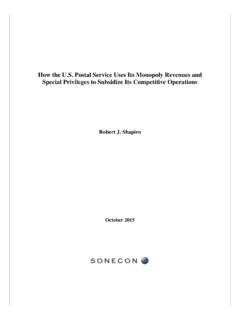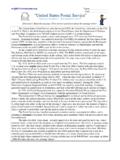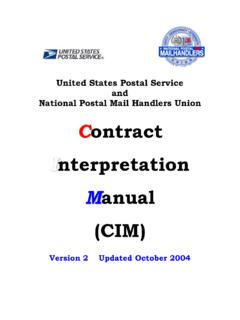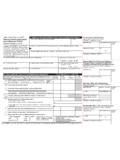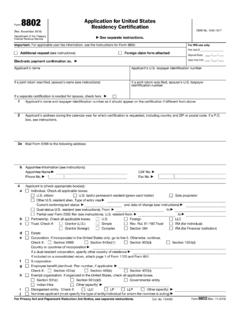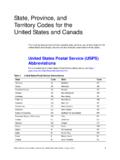Transcription of The Basis and Extent of the Monopoly Rights and …
1 The Basis and Extent of the Monopoly Rights and Subsidies Claimed by the united states postal Service Robert J. Shapiro March 2015 1 Table of Contents I. Introduction .. 2 II. Background .. 5 III. The Performance and Financial Condition of the USPS .. 9 IV. The Value of the Subsidies Arising from USPS s Special Status .. 14 V. Conclusions .. 22 Appendix .. 24 References .. 25 About the Author .. 27 2 The Basis and Extent of the Monopoly Rights and Subsidies Claimed by the united states postal Service Robert J. Shapiro1 I. Introduction Governments always have compelling reasons to communicate with their citizens, so some form of postal service has been a public good that most governments have provided since at least the 18th century.
2 postal systems also provide ways for businesses and individuals to communicate with each other, giving rise to private companies prepared to compete with public postal systems. This competition has intensified with the recent spread of advanced information and communications technologies, and policymakers around the world must now grapple with the Extent to which the services provided by public postal systems can or should be altered. In this regard, policymakers in united states , the European Union, Japan and other places have studied where their public postal systems monopolies should end and competition should begin, and the terms on which private firms should compete with their public postal systems.
3 In most cases, the core of the public system Monopoly is delivery of letter mail on a near-universal Basis . So, wherever any person lives or works in the united states , she or he can usually count on the united states postal Service (USPS) delivering letters six days per-week. Competition here and in most developed nations is allowed for express mail and package delivery. In the Monopoly sphere, universal postal service is supported by a range of subsidies, including appropriations, exclusive access to residential and business mailboxes, borrowing subsidies, and favorable tax treatment. The relatively low-cost delivery of letters in dense areas such as large commercial and residential buildings with central mail rooms also subsidizes higher-cost mail delivery to more isolated homes and businesses.
4 Finally, the public systems can draw on economies of scale and scope in their Monopoly spheres to reduce their costs in competitive For example, the USPS visits most homes and businesses on a daily Basis . This core function, supported by laws barring private firms from using residential and businesses mailboxes, enables the USPS to pick-up packages from any home or business at little additional cost. This produces a network advantage, since a private competitor s cost to pick up and deliver a package exceeds the USPS s incremental cost to pick up and deliver the same package, along with its normal letter In Sweden, where mail and package delivery have been fully privatized, ubiquitous letter-mail service is considered a competitive advantage for the incumbent operator, rather than a burden.
5 4 This report surveys and estimates the current Extent of USPS subsidies, including those which it claims directly such as lower borrowing costs and broad tax exemptions, and more implicit subsidies arising by its Monopoly and attendant economies of scale and scope. 1 I want to acknowledge the superb research assistance provided by Doug Dowson and the support for that research provided by united Parcel Service, Inc. The analysis and views are solely those of the author. 2 OECD (2001).
6 3 Sidak (2007) 4 OECD (2001) at 9. 3 The Value of USPS Subsidies The subsidies claimed by the USPS have to be evaluated in the context of the additional costs imposed on the USPS by the Congress. For example, Congress requires the USPS to maintain residential deliveries six days per-week, and the postal Regulatory Commission (PRC) estimates that reducing deliveries to five days per-week would save the USPS more than $ billion per-year. Similarly, Congress mandates discounted mail rates for religious, educational, charitable, political and other non-profit organizations, which cost the USPS more than $ billion per-year. Congress also directs the USPS to provide a special mailing rate for periodicals (at a cost of $521 million per-year) and restricts USPS s ability to close inefficient post offices (at a cost of $332 million per-year).
7 The PRC estimates that all told, legal and regulatory requirements cost the USPS about $ billion per-year. This total corresponds roughly to the USPS s average reported deficit over the last decade ($ billion per-year) and to the PRC s estimate of the total value of the USPS s special privileges ($ billion), including its Monopoly on delivering letters ($ billion), exclusive access to residential and business mailboxes ($810 million), and exemption from state and local taxes and fees ($ billion). As a result, USPS and representatives of its employees maintain that the agency is financially As we will see, the PRC s estimates substantially understate the value of USPS s subsidies.
8 We estimate that USPS monopolies and related special treatment produce effective subsidies worth nearly $18 billion per-year. For example, the PRC estimates that the USPS Monopoly on access to residential and businesses mailboxes was worth $810 million in FY 2013. The USPS itself has said (2008) that ending the current bar on private delivery companies accessing mailboxes would cost the USPS $ billion to $ billion In fact, USPS s Monopoly access to mailboxes is worth much more, especially since the USPS s Monopoly access applies to both its Monopoly on regular mail and its competitive package delivery business. Exclusive access to mailboxes allows USPS to leave mail in curbside mailboxes or centralized mailrooms in large residential and commercial buildings rather than delivering to every customer s door, as private delivery services must do.
9 Based on USPS data on the volume of mail delivered to curbside mailboxes and centralized mailrooms, and the costs of doing so compared to delivery to each customer s door, we estimate that the mailbox Monopoly saved USPS $ billion in FY 2013, compared to the burdens of private delivery companies. Similarly, the PRC estimates that the USPS Monopoly on first-class and standard mail delivery was worth $ billion in FY 2013. This PRC estimate relies on a model that projected USPS net income with and without its Monopoly over letter delivery. The model assumed that in absence of this Monopoly , a competitor would deliver such mail three times per-week, reduce delivery costs by 24 percent, cut labor costs by 10 percent, and discount its service by 10 percent.
10 We approach this issue in a more fundamental way: In the absence of this Monopoly , USPS would face full competition from private companies and be forced to undertake new strategies and investments to match the productivity of its private rivals. The Bureau of Labor Statistics (BLS) reports that from 1987 to 2012, USPS productivity grew at an average annual rate of percent, a fraction of the percent annual productivity by private firms in shipping, delivery, 5 In April 2013, the president of the National Association of Letter Carriers appeared before the House Committee on Oversight and Government Reform and testified that the USPS has received no taxpayer subsidies since 1983.
